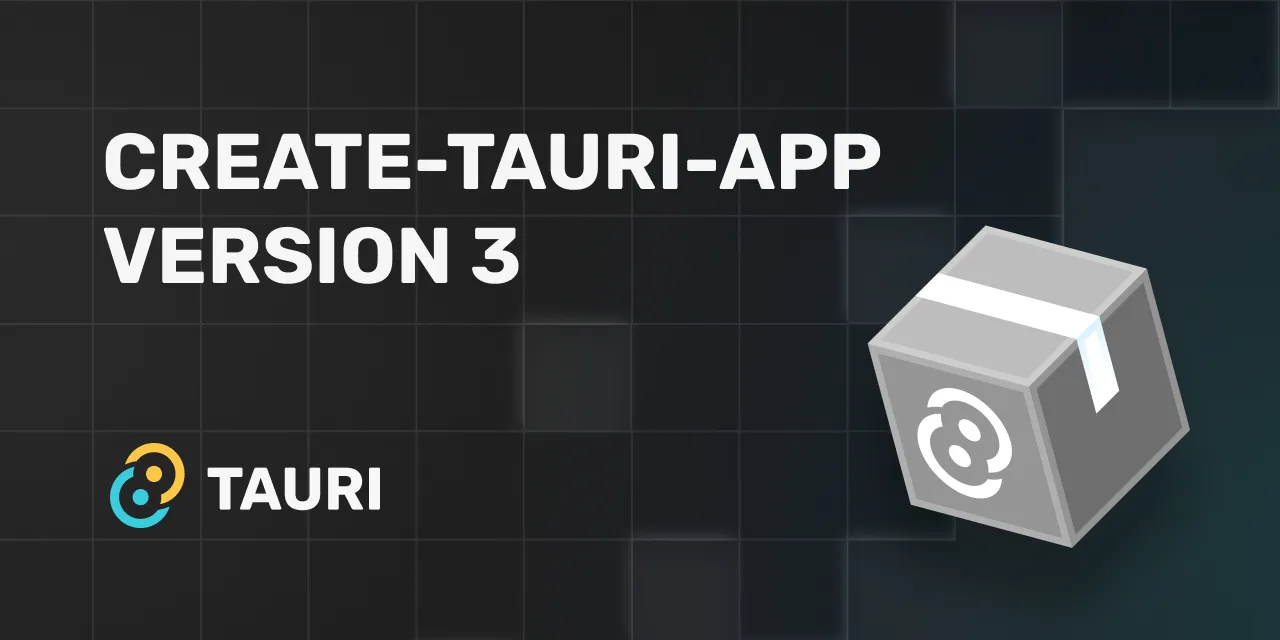create-tauri-app Version 3 Released
Esta página aún no está disponible en tu idioma.

A new major version of create-tauri-app has been released. This version adds support for the alpha version of Tauri 2.0, the ability to initialize iOS and Android projects and removes some less commonly used templates to make the project more maintainable.
The first alpha version of Tauri 2.0 was published almost 3 months ago which brought initial mobile support for Android and iOS. Previously there wasn’t an easy way to create a new project to test either the changes in the alpha version nor the mobile support. Well, that ends now!
Starting with version 3 of create-tauri-app, you can now pass --beta flag and it will bootstrap an app that uses tauri@2.0.0-beta. When adding the --beta flag it will automatically prompt you if you’d like to add mobile support. You can also use the --mobile flag to automatically make it mobile compatible.
To get started:
# pnpmpnpm create tauri-app --alpha
# yarnyarn create tauri-app --alpha
# npmnpm create tauri-app -- --alpha
# Cargocargo install create-tauri-app --lockedcargo create-tauri-app --alpha
# Bashsh <(curl https://create.tauri.app/sh) --alpha
# Powershell$env:CTA_ARGS="--alpha";iwr -useb https://create.tauri.app/ps | iexWith version 2 of create-tauri-app we also focused on improving the flow and experience of the prompted questions.
Previously the second prompt would ask “Choose your package manager”. This was a bit vague and could leave some with unanswered questions:
- What is
cargo? - Is it a new Node.js package manager?
- Why choose it over
pnpmoryarn?
This would be even more vague if we decided to add a new frontend language (such as a webassembly Golang web application). We added a prompt asking to choose the package manager to ask which language would you prefer. It looks something like this:
? Choose which language to use for your frontend › Rust❯ TypeScript / JavaScript (pnpm, yarn, npm)After choosing the frontend language create-tauri-app will then prompt for package manager to use if the language has multiple (such as Node.js with npm, yarn, and pnpm).
Another prompt that we felt problematic was the template selection prompt. It contained a lot of templates to choose from and was only growing with time:
✔ Choose your package manager · pnpm? Choose your UI template › vanilla vanilla-ts vue❯ vue-ts svelte svelte-ts react react-ts solid solid-ts next next-ts preact preact-ts angular clojurescript svelte-kit svelte-kit-tsWe decided to split this up into 2 prompts. The first will ask which UI template to use:
✔ Choose your package manager · pnpm? Choose your UI template › Vanilla❯ Vue Svelte React Solid Angular Next SvelteKit ClojureScript PreactAnd then the second will then ask any additional choices that are specific to that template (such as choosing between TypeScript or JavaScript for Vue):
✔ Choose your package manager · pnpm✔ Choose your UI template · Vue - (https://vuejs.org)? Choose your UI flavor ›❯ TypeScript JavaScriptEven with these refinements the list of templates was still quite large and would only grow over time. The next thing to look at was the list of templates themselves.
When create-tauri-app version 2 was launched it quickly received PRs to add additional templates beyond what it originally launched with. While it was exciting to receive so much support from the community, it did bring up a couple of new challenges:
- It made it almost impossible to fit them in a single prompt
- Maintaining all the templates was becoming more difficult
It was a hard balance between showing how flexible Tauri is but also making sure that the project was maintainable and had the DX that we wanted.
We decided to focus on the most popular frontend frameworks and used guidance from community surveys like The State of JS and our own Tauri community feedback. With this we removed the next, next-ts, preact, preact-ts, clojurescript, svelte-kit and svelte-kit-ts templates and also closed PRs which aimed to add more templates.
Community-Maintained Templates & Previous Versions
Section titled “Community-Maintained Templates & Previous Versions”We want to make sure that we offer a place for the Tauri community to provide their own templates for the frameworks they love. The templates section of awesome-tauri is just the place for that. We invite the community to submit a PR to the awesome-tauri repo with their templates so that they can be shared with the Tauri community. We’ll also be creating a section on the Tauri website to highlight and showcase these community templates.
If you’d still like to use the previous templates from version 2 of create-tauri-app they are still published to npm and crates.io. Here’s how you can use a previous version:
# pnpmpnpm create tauri-app@2
# yarnyarn create tauri-app@2
# npmnpm create tauri-app@2
# Cargocargo install create-tauri-app --version 2.8.0 --lockedcargo create-tauri-app
# Bashsh <(curl https://create.tauri.app/v/2.8.0/sh)
# Powershelliwr -useb https://create.tauri.app/v/2.8.0/ps | iexHowever, as time goes, these templates will become out of date as Tauri and the frontend frameworks move forward. We’d recommend you look at the community templates in the awesome-tauri repo and welcome submissions if something is missing.
We hope that these changes make it easier for the community to try out the alpha and beta versions of Tauri 2.0 and also make the process to create a new Tauri app easier for everyone! We’d love to hear your feedback and invite you to join the conversation on the GitHub Discussion for this post.
© 2025 Tauri Contributors. CC-BY / MIT